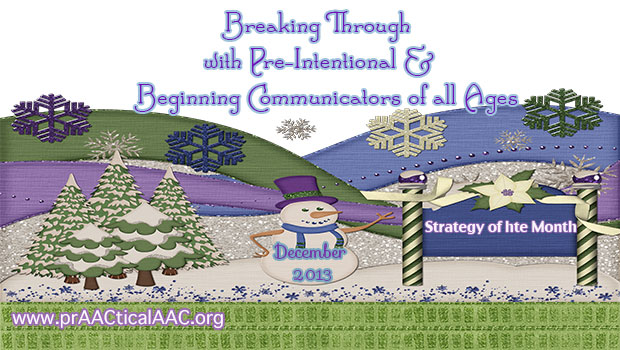Breaking Through with Emerging Intentional and Beginning Communicators of All Ages

We are thinking a lot about emerging-intentional and beginning communicators. Even within these categories it seems there are sub-categories. We have a subset of learners who seem difficult to engage. They do not often respond to communication initiations by others. They can be content looking at small items or through self-stimulatory behaviors. These learners can get “communication” overlooked in class, in intervention, and at home because they can be quiet and subdued a lot of the time. They can be prompted through activities and events without difficulty but they often do not get to be communication initiators. And without a lot of practice initiating, it is hard to improve.
You may hear or think these things about the learner:
- She does not like anything
- He is in his “own world”
- He does not care what he gets
- It seems like she can not hear
- She does not look at what I show her
- He looks right past me
It is important to remember that these descriptions focus on weaknesses. It is much more helpful to focus on the learner’s strengths. This allows solutions and teaching strategies to be chosen and developed. So instead of focusing these vague weaknesses, look for actions and behaviors that will help improve communication.
Strength Based Perspective- What to look for:
- Times of happiness (a small smile, a giggle, a laugh)
- Times of distress (whining, crying, agitation, backing away, pushing something away)
- Where they go sit, stand, walk
- What they take to eat or drink
- What they hold in their hands, what they do with their hands or feet
- What they look at
Strength Based Perspective- What to do:
- Go big or go small-If big movements loud sounds, exaggerated laughing catches attention, do it. However some learners get overwhelmed by too much and they do better if you use a small voice and small movements to attract attention.
- Require physical movement as part of meaningful language experiences. Avoid waiting time. Have the learner take the materials out of boxes and bags. Have them carry their own materials to the table or place you will use them. Have them assemble pieces. Make sure they are physically busy to whatever degree that is possible. Have the learner put materials away when they are finished. If the learner tends to let things slide out of their hands, use bags with handles that can be hung around their hand or shoulder. Walking and holding things requires a certain amount of attention beyond self and makes it easier for engagement.
- Develop communication temptations that are meaningful to the learner- There are always the classic communication temptations (a closed see-through jar, bubbles with the cap on tight, a locked door), however these may be of no interest to a pre-intentional or beginning communicator. Instead use the list of ‘what to look for’ to determine meaningful communication experiences. If the learner only twirls a leaf, then get lots of leafs for twirling. Take the leaf after a few seconds, but offer another one until it becomes expected. Then you have developed a meaningful communication temptation. Move slowly through the waiting for the next leaf phase to taking your hand, to giving you a jar with the leaves in it.
- Use repetition of communication temptations that work- Once you get a temptation that works and the learner shows interest, do it many, many times. Just because you may be bored does not mean the learner is also feeling that way. Even if it feels redundant (asking for a leaf 50 times), it is probably not to the learner. Be careful though, watch for boredom signs from the learner and be prepared for it to only work at one time and place. Don’t be surprised if it worked in the morning but does not work in the afternoon or especially the next day. Always watch for behaviors that show different lines of interest and engagement.
- Consider sensory activities- Add in sensory activities that help the under-responsive learner become more engaged and activities that help the over-responsive learner calm down and become more engaged. If you can, ask the occupational therapist (OT) for suggestions. If there is not an OT involved, look for movement experiences that help. Some learners do well with warm-up exercises, swinging on the playground, obstacle courses (set up in the therapy room or hallway), while others do better with soothing music.
- Use Aided Language Input (ALI)- Use lots of aided language input. These learners often remember everything even if they do not seem to be paying attention. Peripheral vision is often better than we think, eye contact is nice but not always necessary to learning.
- Create routines and then violate the routines- Develop routines for the beginning and end of experiences, sessions, activities and then make some changes. If the learner does not notice, you can comment yourself. Then go back to the routine and after awhile or when the learner follows or expects the routine, change it. After doing this several times (or more), the learner will often let you know that you have messed the routine up. When that happens, you have intentional spontaneous initiated communication.
Strength Based Perspective- Philosophies
- Presume Competence- Assume that the aided language input is going in and that the learner is remembering everything, even if you are not seeing equivalent output. It may take many thousands of opportunities of experiencing meaningful targeted communication before you see spontaneous initiation.
- Know that Everyone Communicates- Behavior and actions communicate things even if it was not on purpose. We use these actions and behaviors to turn unintentional communication acts into intentional ones.
Filed under: Strategy of the Month
This post was written by Robin Parker


